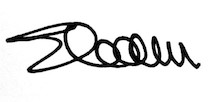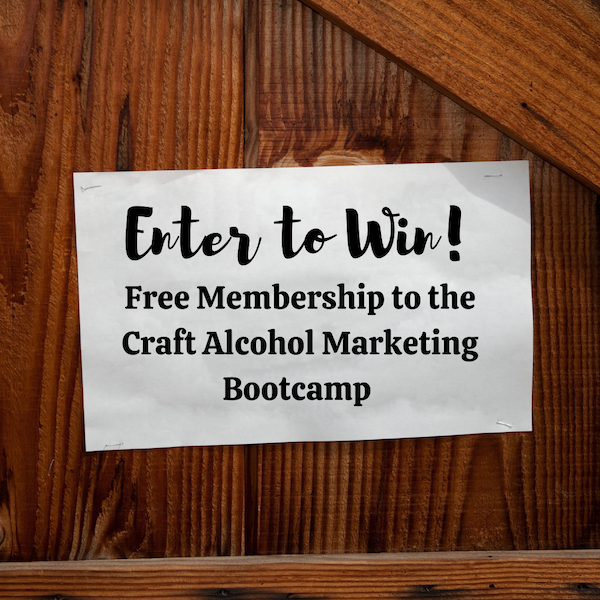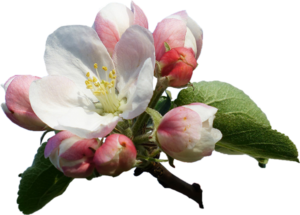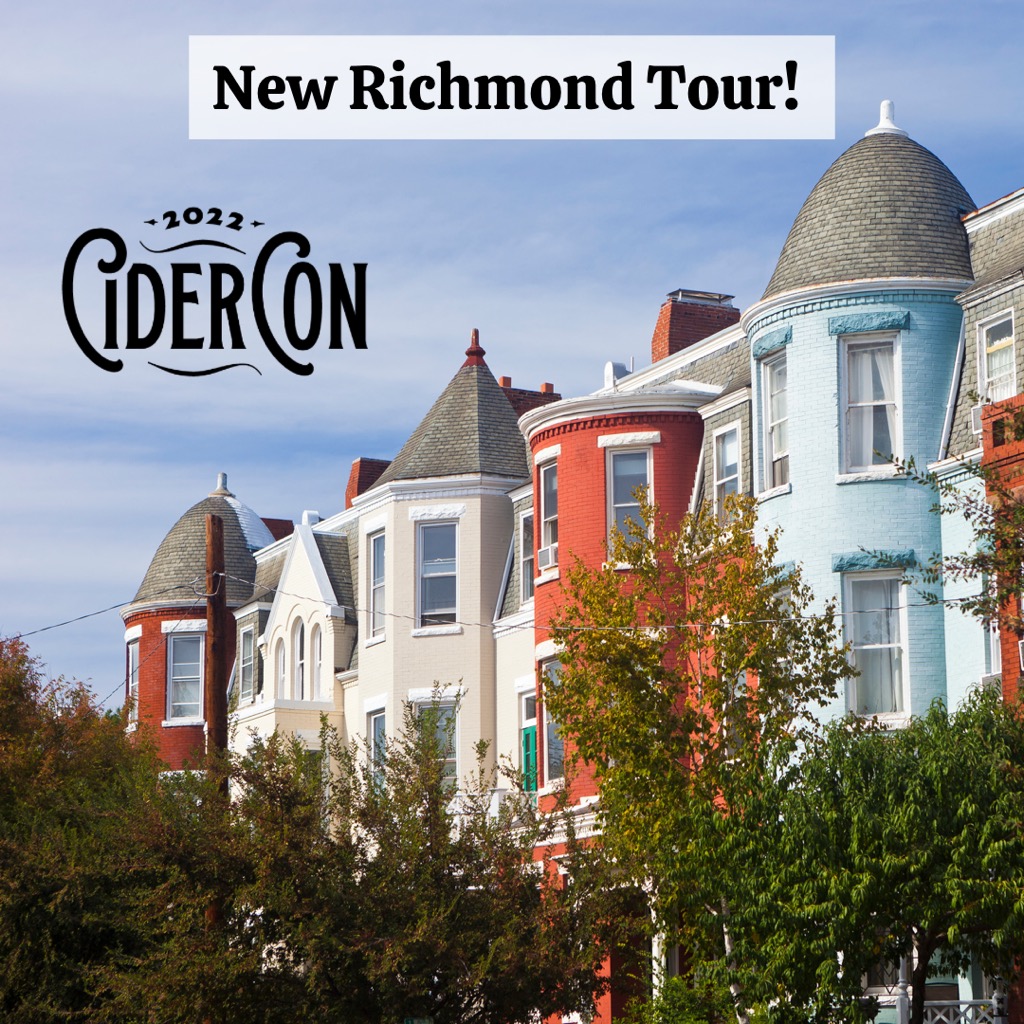Posts by Woodley Smith
Webinar: BeerBoard’s Hard Cider Trends
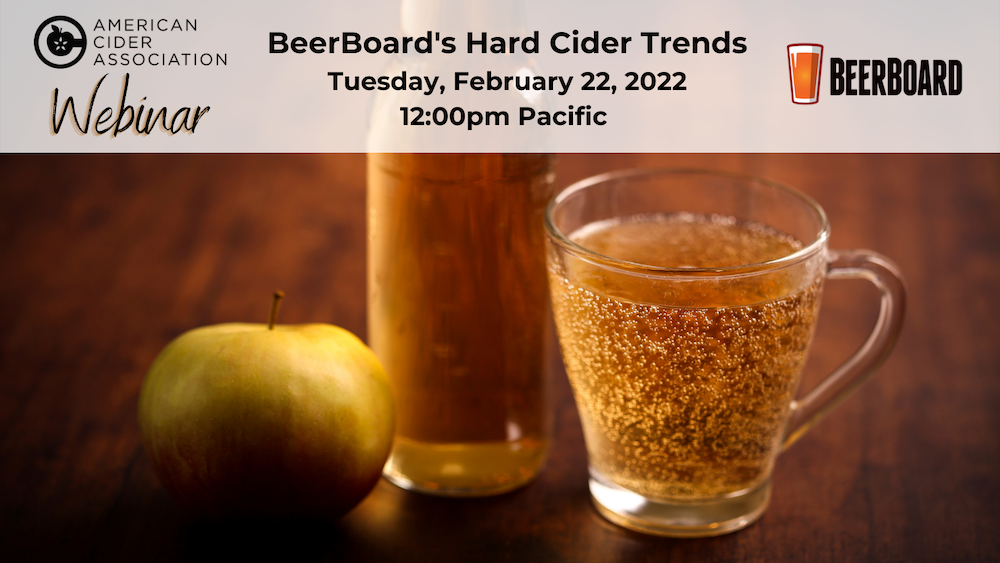
BeerBoard’s Hard Cider Trends Webinar February 22, 2022
Join Dillon Card and Jim Randall from BeerBoard for the newest on-premise insights for cider with national and regional breakdowns, including competitive style and product performance data. This webinar will take place Tuesday, February 22, 2022 at 12:00pm Pacific on Zoom. Zoom link will be provided the day before the webinar.
This webinar is for active ACA members only. Join now or renew your membership!
CiderCon® 2022 Fact Sheet
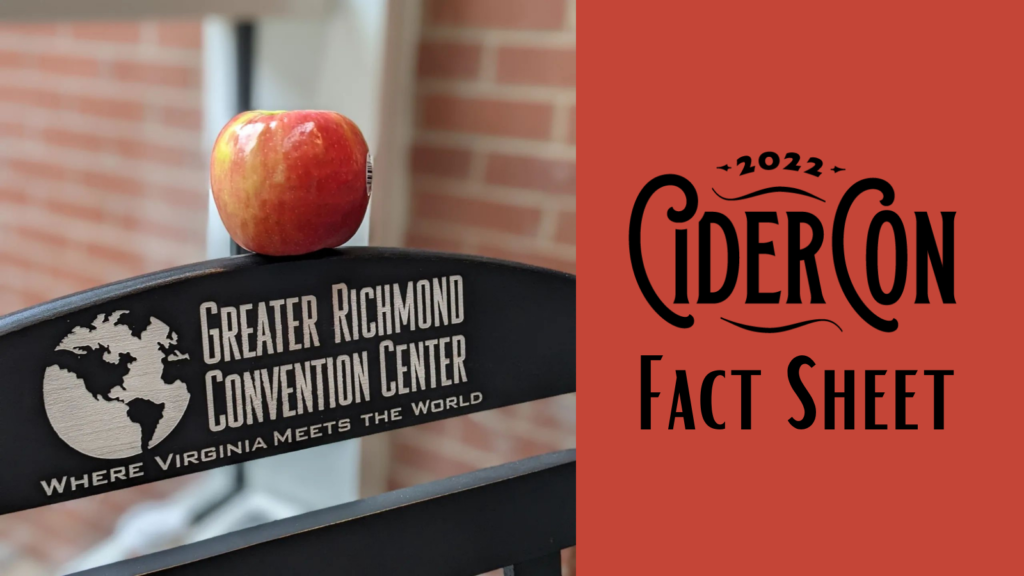
- The 12th Annual CiderCon® took place in Richmond, Virginia from February 1 to February 4, 2022. This was a return to an in-person event after holding CiderCon 2021 in a virtual space. CiderCon® is the American Cider Association’s annual event. This year’s theme was Southern Cider.
- On the main two days of the conference, 37 workshops presented information on 8 tracks. The tracks were: apples and orcharding, cidermaking, flavor and terroir, sales and distribution, marketing and trends, better business, legal and compliance, and history. The schedule can be downloaded here.
- 36 states and DC were represented with Virginia, New York, Washington, California, Oregon, and Pennsylvania sending the most attendees.
- 805 people attended the conference, and there was an increase in the number of regular ticketed attendees participating compared to the last in-person conference in Oakland, CA in January 2020.
- This year’s trade show featured 73 vendors including several veterans from past CiderCons®, as well as an impressive number of first time exhibitors who were excited to meet professionals from cider’s growing industry.
- James Beard finalist and multi-nominee Diane Flynt of Foggy Ridge Cider was the event’s keynote speaker. She discussed the history of Southern apples and cider and the lessons that modern growers and cidermakers can learn from that history.
- There were 11 tastings sessions in total for CiderCon® 2022 including sensory evaluation and food pairing workshops, crab apple cider tastings, Southern apple cider tastings, a sensory review of Northern Michigan ciders, low-abv cider cocktails and more.
- The American Cider Association partnered with the Cider Institute of North America to co-develop a large production oriented and technical-in-nature workshop track with 9 sessions on topics from producing cider using wild fermentation to fruited cider to creating ciders with residual sugar. The Cider Institute of North America trains cider makers through their educational programming in partnership with universities like Cornell.
- In addition, CiderCon® held several orcharding sessions for growers. Beginning sessions included an introduction to holistic orcharding practices and a hands-on grafting workshop. Advanced concept sessions included integrated pest management solutions for both diseases and insect pests.
- Sessions also focused on lessons that can be learned from other craft beverage industries, including tourism, sustainability practices, clubs, and barrel aging.
- The American Cider Association offered its Certified PommelierTM exam at CiderCon® 2022, an advanced second level designation of its Certified Cider Professional program geared toward beverage and hospitality industry professionals. More than 30 people sat for the challenging test that includes a blind sensory evaluation section. The new cohort of Certified PommeliersTM will be announced in 6 weeks.
- More than 150 people took one of 5 tours during CiderCon® 2022. The first overnight tour was offered to the Northern Shenandoah Valley of Virginia, in addition to tours to the Virginia apple growing regions of Albemarle County and Nelson County. There was also a tour of Richmond based cideries and a tour of the historic Jackson Ward area of Richmond–once known as Black Wall Street. The tours were coordinated the Virginia Association of Cidermakers and the Virginia Wine Board Marketing Office.
- The ACA launched an equity pledge at CiderCon® and two sessions directly addressed methods for building a more inclusive cider industry. Day Bracey, founder of Barrel & Flow (formerly Fresh Fest), discussed how he and his team built one of America’s most inclusive brew festivals and the initiatives behind it. Dr. J. Nikol Jackson-Beckham of Crafted For All and the Brewer’s Association returned to CiderCon® to cover a variety of practical pipeline development strategies to help cider business successfully increase the breadth, depth, and diversity of its pool of qualified job applicants.
- CiderSoms hosted CiderCon®’s first ever BIPOC Cider Professional Meetup and Pomme Pride hosted their first meetup for LGBTQIA+ cider industry professionals.
- Richmond Cider Days, an unaffiliated list of cider events sponsored by the Virginia Association of Cidermakers, took place during the week of CiderCon® with 30 events ranging from single varietal tastings, to tap takeovers, to cider pairing dinners.
- The American Cider Association’s annual board elections happen concurrently with CiderCon®. Newly elected board members were announced during lunch on Friday and include: Christine Walter of Bauman’s Cider in Oregon to an At-Large Seat, and David Glaize of Glaize & Bro. Juice Co. and Old Town Cidery in Virginia as the Southern Chair. Eleanor Leger of Eden Ciders in Vermont was re-elected to Eastern Chair and Ben Calvi of Vermont Cider Co. was re-elected to a Large Cidery Seat.
- The American Cider Association’s board recognized Diane Flynt of Foggy Ridge Cider in Virginia and Dan Pucci of New York, co-author of American Cider, for their significant contributions to the cider industry.
CiderCon® 2023 will be held in Chicago, IL from January 31 through February 3, 2023.
CiderCon® was created to offer the commercial cider industry an outlet to meet, share ideas, collaborate and affect positive changes in cider making and cider fruit production best practices, the cider market and cider regulations. CiderCon® is organized by the American Cider Association whose mission is to grow a diverse and successful U.S. cider industry by providing valuable information, resources and services to our members and by advocating on their behalf.
ACA Announces Board Election Results
Last Friday, the American Cider Association (ACA) announced the results of their annual board of directors election at their 2022 industry trade conference called CiderCon®, held this year in Richmond, Virginia. The ACA is the nation’s non-profit trade group working to protect and advance the hard cider industry. Christine Walter of Bauman’s Cider in Gervais, Oregon was elected by members to the ACA board as a director-at-large and David Glaize of Old Town Cidery in Winchester, Virginia was elected as the Southern Chair, tasked with serving as the liaison for the ACA’s Southern members and the Board of Directors.
Notably, both new board members are multi-generational apple growers in addition to being cidermakers. Apples are a critical ingredient in cider’s production as all hard cider–traditional, bottle-conditioned, fruited or otherwise–is made from fermenting apple juice using the same fermentation methods as wine. Having a substantial grower presence on the board of directors connects the board further with cider’s most important ingredient–apples.
New ACA Board Members
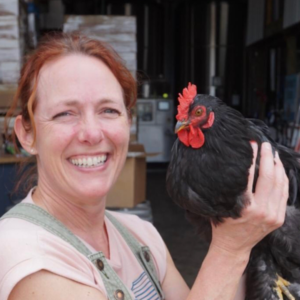
Christine Walter grew up on the family farm, Bauman Farms, in rural Oregon. Raising apples and pressing juice with her family are some of her earliest memories. She studied Biochemistry in college, and eventually made it back to the farm where she now makes award winning Bauman’s Cider in the barn. She is currently a member of the board of The Cider Institute of North America, close partners of ACA. She is energetic, creative, and strategic.

David Glaize is a 4th generation apple grower in Winchester VA, and co-owner of Old Town Cidery. Alongside his brother (Philip) the two convinced their dad to plant cider varieties back in 2010, and to construct a processing facility in 2018. The juice company, Glaize & Brother Juice Co, provides custom juice blends to cideries, wineries, and breweries up and down the East Coast. In working to keep the family business vertically integrated, David and his brother opened Old Town Cidery in 2021. David is a member of US Apple–a trade group for apple producers–and hopes to help deepen the relationship between the two groups. He is passionate about consumer education and farmland protection.
2022 ACA Board Officers
The ACA also announced the results of their 2022 board officer elections. Dave Takush, the head cidermaker of 2 Towns Ciderhouse in Oregon joins the ACA’s executive committee as Secretary. John Behrens of Farmhaus Cider in Michigan served as the board secretary in 2021 and was newly elected as Treasurer for 2022. Brooke Glover of Swilled Dog in West Virginia and Eleanor Leger of Eden Specialty Ciders in Vermont were both reelected as Vice-President and President, respectively.
“I’m excited to work with our fantastic board and our diverse membership to move the cider industry forward with the trade and regulators. Together, we will help American drinkers of all demographics discover and enjoy the amazing range of great ciders in the marketplace,” says Leger.
Retiring Directors
Paul Vander Heide of Vander Mill Cider in Michigan and David Thornton of James Creek Cider House in North Carolina both completed their ACA board service this year.
“Paul and David are both incredibly strong leaders,” says ACA executive director, Michelle McGrath. “Paul and I have worked very closely together to grow the ACA since my hiring in 2016. It’s been an honor to work with him and learn from his mentorship. And David was a force for positive change. I am a better leader for having worked with both Paul and David, and I will miss their presence on the board tremendously.”
Membership Meeting
The ACA will hold its annual virtual membership meeting, with opportunities to meet board member, on March 8, 2022 at 10AM Pacific. Members will be sent meeting details by email.
“Our virtual membership meeting last year was a big success. The board loved it so much we’re going to do it every year now,” says McGrath. “It’s a great chance to talk more deeply about strategic initiatives on the heels of CiderCon® conversations.”
###
ACA Board Elections
Please meet the candidates for the 2022 Board of Directors! We will email active cidery level members their ballots Wednesday and they will close Friday.
At Large Cidery Seat – 3 Candidates
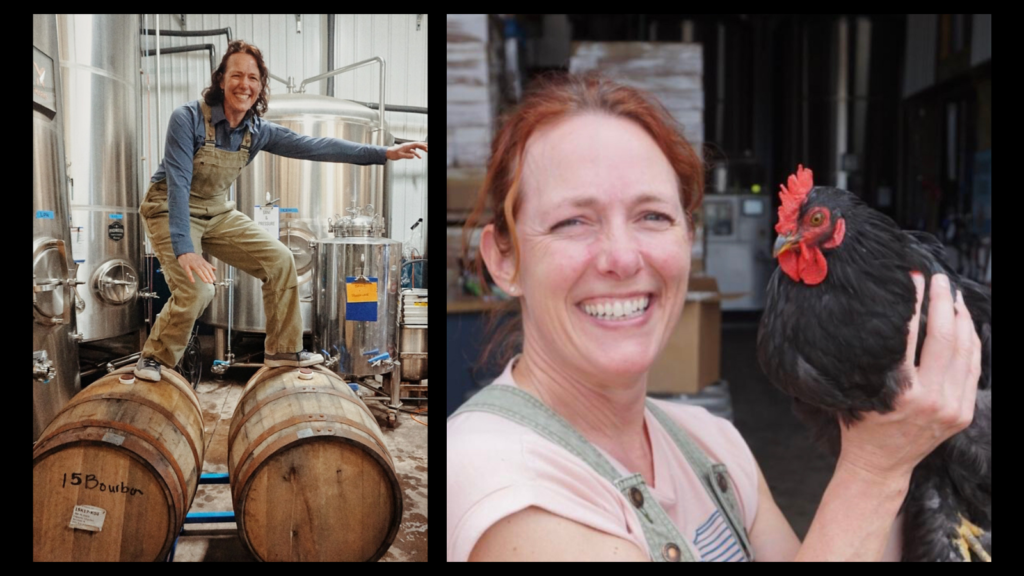
Christine Walter, Bauman’s Cider Company
I know that an organization like the American Cider Association makes a thousand small decisions and hosts hundreds of conversations all along the way to be the effective industry-shaping force that it is. Casting a broad net with regard to diversity and inclusion is no little thing. Spearheading and advocating for the kind of lasting legislation that makes or breaks cidermakers of all sizes is transformative work as well. I want to bring my creativity and energy to the board, to help shape the conversations and lean on my experiences as a small farm-based producer to make the climate of cidermaking more friendly to both big and small cider businesses.
ABOUT CHRISTINE
I grew up on my family’s farm in rural Oregon. Raising apples and pressing juice with my family are some of my earliest memories. I studied Biochemistry in college, and started and ran a small retail company for 22 years before discovering and quickly falling in love with cider. It took me a couple years to convince my family that cider was a real thing and that I might be able to make it on the farm if they would only let me use a small corner of a barn.
I think you can imagine that I have since taken over the whole barn, and created a huge following among my family. And I absolutely love making cider, drinking cider and being around cider makers!
I am currently a member of the board of The Cider Institute of North America and regular guest instructor.
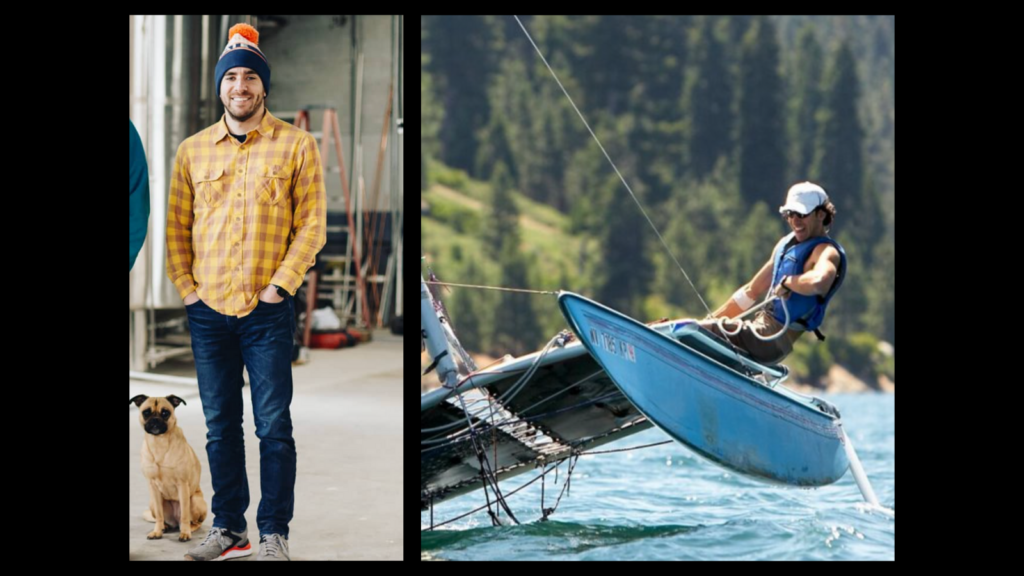
Adam Ruhland, Wild State Cider
I want to see your cidery succeed. The realities of owning a successful cidery extend well beyond making amazing liquid. I’d like to help support the ACA and it’s members by being a champion for practical resources and initiatives for the average cider business owner. This includes increased support and programming around finance/funding, marketing, distribution, product innovation, human resources, and retail strategies.
It’s a tough market out there for even the most established brands, and we need to work together to grow our individual cideries and, in turn, the whole category. Cider exists in a strange and ever-changing place in the alcohol market. Our relevance depends on the strategies used by our members to meet our customers where they are, which involves frequent change and re-thinking how we operate our businesses.
As a board member, I’ll help the ACA maintain a focus on how it can practically support the needs of the average member working hard to succeed in a crowded market.
ABOUT ADAM
Adam Ruhland is the co-owner of Wild State Cider and president of the Minnesota Cider Guild. WIld State is a Duluth, MN based cidery started in 2019 that sells cider in five states and employs 27 individuals. Adam spent five years as a special education teacher before making the jump to entrepreneurship. He believes anything is possible through creativity, hard work, and education. Adam is married with two young children, a dog, and a cat named Kevin. He loves cross-country skiing, trail running, and mountain biking with his kids.
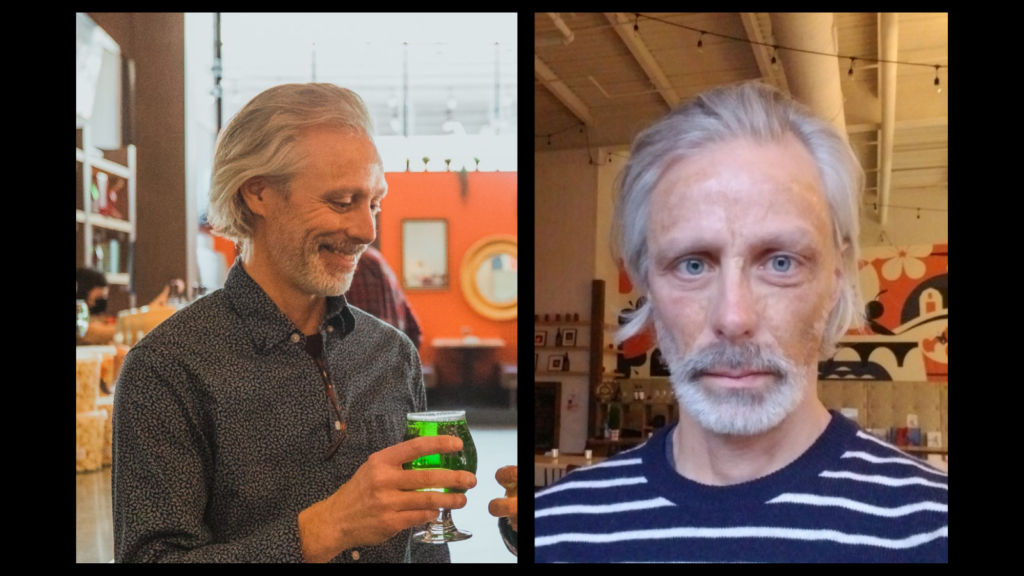
Steve Hance, Number 12 Cider
One thing my experience in serving non-profits has taught me is that there is typically no shortage of great ideas but a great shortage of initiative. Volunteer board members have day jobs that take priority and organizations often struggle to find people that will actually dedicate real time and effort to the organization. For better or worse, I have always been one to raise my hand and volunteer my time when it comes to this kind of service. The reward is seeing the positive impact and being directly involved in something worthwhile.
We all want to see cider grow, and hopefully not just for the bottom line, but because we want to share the joy of cider with everyone. I think a strong ACA is critical for that goal.
The ACA has already made great strides to help cider grow since its inception. CiderCon is an incredible event for us to come together and share ideas. The CCP program is a great way for us to develop our own conventions. Gathering and sharing market data is essential for us to understand how we can fit in to the economy and grow.
Moving forward, I would like to help the Board expand on these and other existing initiatives, but also to find new ways to connect with more of those potential cider-makers and drinkers out there. One thing I see for cider compared to other products, is a lack of resources for people seeking to learn how to start making cider themselves and all of the different styles of cider.
We have a great foundation, lets build on that but also start looking beyond the die-hard cider fanatics and market to the next generation of cider-makers.
I would be honored to serve on the Board if you choose to elect me.
ABOUT STEVE
I am the President of Number 12 Cider in Minneapolis where I live with my wife and our 14-year-old son. I have been making cider for about 25 years. Most of that time I have been “that guy” who always had plenty of cider to share whenever the chance arose. I am a student of history, and I love learning about the tradition and history of cider.
Although I am a lawyer by trade, a few years ago I decided to follow my passion and started an orchard-based cidery in the small town of Buffalo, Minnesota with my friend and business partner Colin. We were one of the first cideries in Minnesota when we started in 2014. Four years later we built a new facility in Minneapolis.
I helped to create the Minnesota Cider Guild where I have served as its President and Treasurer. It has been a joy to see cider grow in Minnesota and nationally since then. Outside of my law career and cider, I have dedicated countless hours to other non-profits as Organizer, Board Member, President and other posts.
Eastern Chair
CT, MA, ME, PA, NH, NJ, NY, RI, VT.
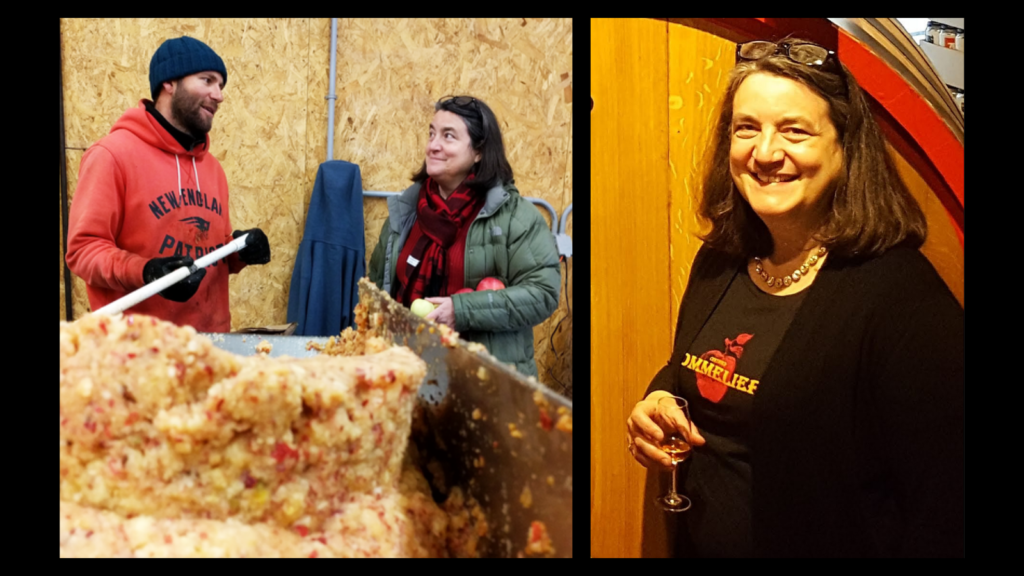
Eleanor Leger, Eden Ciders
I believe more than ever that cider’s future is strengthened when we draw the connection from apples to orchards to cider. Stories of growers, varieties, and the flavors that apples bring to ciders and to food pairings are what can move people to a greater appreciation of the diversity among cider offerings and a greater openness to considering cider as a choice on the shelf or at the table. These stories will benefit large and small cideries alike, across all price points and methods. Our fruit is what makes our product more expensive than grain or cane sugar-based alcohols. We all must celebrate it if we are to claim the price points we need for economic sustainability across size and method. In this sense, we are truly united in our “big tent” approach. All cider is made from apples and we as a category share pride in that. As passionate as I am about the high end, expensive ciders I make from rare and delicious apples, I want cider as a broad category to succeed, at all price points and across all processes. I am excited to engage with all the wonderful cideries in the large Eastern Region, to seek their input and feedback, to work collaboratively with Michelle and fellow board members to reach sound decisions, and to move us all forward.
ABOUT ELEANOR
Eleanor started producing ice cider with her husband Albert in the basement of their Vermont farmhouse in 2007. For the next eight years they built the business themselves, planting 1,000 trees, developing partnerships with other small local orchards, and working together in the cellar to produce ice ciders, and eventually expanding into dry wine-style ciders and apple-based aperitifs.
Today Eleanor primarily runs the business, the team has grown to six people, and in 2020 they launched a new line of harvest-driven ciders in cans. Before cider Eleanor was an over-educated execu-mom who was underwhelming her potential in corporate america. Now she parses TTB forms and depletion reports with gusto. With spare time she doesn’t have, she occasionally writes about small cidery economics at cidernomics.com.
In addition to serving on the board of the ACA as an At Large Member from 2015-2018, and Eastern Region Chair from 2019 to the present, Eleanor is a founder of the Vermont Cider Makers Association, and was appointed to the inaugural Vermont Working Lands Enterprise Board, proving once again that the road to hell is paved with good intentions.
Southern Chair
AL, AR, FL, GA, LA, MS, NC, SC, TN, VA, WV, MD, DE, DC.

David Glaize, Old Town Cidery & Glaize & Brother Juice Co.
American Cider Association is the liaison between cider-makers/enthusiasts, and law makers, consumers, and buyers. As a member of the ACA board, David will work as the voice for cideries to promote industry growth and to broaden consumer education. David is a 4th generation apple grower and fresh juice provider. His understanding of the base industry will contribute immensely to supporting sustainable practices that lead to high quality juice/cider and hopefully orchard expansion. In selling fresh juice to over a dozen cideries throughout the South, David will represent the southern region with a strong understanding of what cideries need, and what the consumer wants. David has worked/lobbied with USApple and is familiar with policy making that helps protect our industry. With an end goal to keep the land in apple trees, David will do what it takes to get more people drinking more apples!
ABOUT DAVID
David Glaize is a 4th generation apple grower in Winchester VA, and co-owner of Old Town Cidery. Alongside his brother (Philip) the two convinced their dad to plant cider varieties back in 2010, and to construct a processing facility in 2018. The juice company, Glaize & Brother Juice Co, provides custom juice blends to cideries, wineries, and breweries up and down the East Coast. In working to keep the family business vertically integrated, David and his brother opened Old Town Cidery in 2021. David resides in Winchester VA with his wife Mimi, and two children, Charlotte and Walker.
Large Cidery Seat
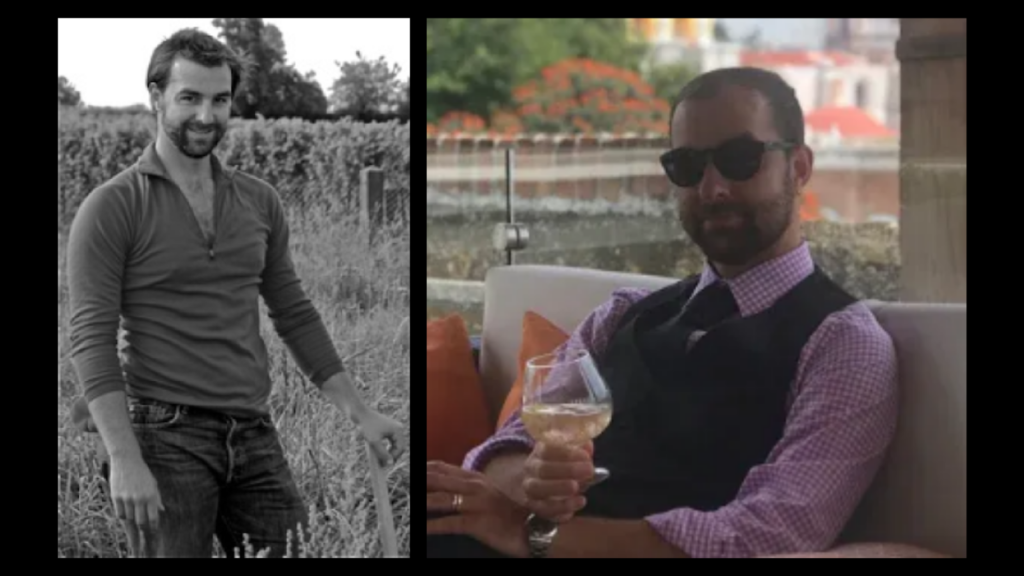
Ben Calvi, Vermont Hard Cider
I have served on the ACA board since 2016 as a representative for large producers. Over the years, I have worked on the CCP, Legislative, Financial, and AEI committees. As board treasurer, I advised the ACA on its business plan, financial policies, and tax returns. I continue to work on the legislative committee addressing legal and regulatory issues important to Cider following passage of the Cider Act in 2015. And most recently, I joined the Anti-racism, Equity & Inclusion committee to support its development and outreach to members. There are 2 strategic goals I am most excited to participate in: (1) building Cider’s Political Power and (2) creating a more Sustainable and Inclusive Future for cider. The ACA has a unique position to speak on behalf of the cider industry. From lobbying efforts in Washington D.C. to liaising with state and regional chapters, the ACA must work to ensure regulations align with how cider is made and sold in the U.S. and to make sure laws and regulations allow all our members to remain competitive and well represented in the bev-alc landscape. Cider is a small and niche industry, however, it is not isolated from the broader social and cultural changes rippling through our nation. In the past few years, the ACA has begun to look within our organization, to educate ourselves, and to advocate for a more diverse and inclusive industry. It is not an easy task, nor always a comfortable one, but it is necessary so that cider becomes a beverage for all and a place where all people feel welcome.
ABOUT BEN
Ben Calvi was born and raised in Vermont and is an accomplished cider & wine maker. He joined Vermont Hard Cider in 2015 and now leads operations as COO. At prior roles in California, Germany, and Vermont, he has made wines and ciders for Quintessa, Esser, the Robert Mondavi Institute, Burklin-Wolf, and Champlain Orchards. Ben earned a Master of Science in Viticulture & Enology from the University of California Davis, a post-Bach from the University of Vermont, and a Bachelor of Arts in Environmental Studies from Middlebury College. He serves on boards of the American Cider, Vermont Cider, and Vermont Tree Fruit Growers associations, and he was a founding member of the Atletico Middlebury Soccer Club. Ben lives in Cornwall, VT with his wife and two children enjoying music, sport, and anything outdoors.
Craft Alcohol Marketing Bootcamp Giveaway from The Crafty Cask

The Crafty Cask is kicking off their 2022 class of craft alcohol makers in their 10-course online Craft Alcohol Marketing Bootcamp and are offering ACA members a chance to win a giveaway (valued at $2,673). One ACA member will be selected to win this membership.
Entries accepted through Friday, February 4th.
Here’s everything that is included:
- Lifetime access to all 10 courses in our Craft Alcohol Marketing Bootcamp AND all new courses added in the future. This includes:
- 12 hours of video tutorials and lessons
- 9 Action Sheets & 40 exercises to put the learnings into action
- 31 bonus downloads, cheat sheets, and templates
- Additional log-ins for anyone else on their team to divide and conquer or train their team more fully.
- A community of craft alcohol makers who will all be starting the course together on February 21st for increased accountability with extra support, challenges, tips, and more.
- Exclusive member-only discounts on their favorite marketing products and services (brand photography, web design, etc…).
- Weekly live drop-in office hours for personalized support.
That’s a $2,673 value of marketing education and support, totally free for one lucky ACA winner.
Interested in entering for a chance to win this phenomenal giveaway! Click here to find the link to enter (you will be prompted to login to your ACA account).
The Crafty Cask Giveaway
This content is for members only.
If you were a member and are now seeing this message, please Renew your membership to continue.
NEW! Additional Richmond Tour Added for CiderCon 2022!

That’s right cider people! There was so much demand for tours that we decided we needed to add one more. A big thanks to the Virginia Wine Board and Virginia Association of Cider Makers for their work in planning this new tour! Now, what do you need to know about this new tour?
Richmond Cider Tour
9:00am – 4:00pm Departure from Richmond Marriott Hotel
$75 includes transportation, lunch, and tastings at 5 cideries
Enjoy getting to know the Richmond area and cider scene with this tour of five cideries. You’ll start out your day with tastings at Bryant’s Small Batch, then head on to Hardywood Craft Brewing to taste their line-up as well. Following lunch (and cider) at Courthouse Creek Cider you’ll take a tour of their facility before heading on to taste at Blue Bee Cider. The day will wrap up with a tasting at Buskey Cider before returning to hotel.
Already registered for CiderCon® 2022, and you’d like to add this tour? You can buy a ticket for this tour HERE.
Not registered for CiderCon® 2022? You can add this on during the registration process. You can register HERE.
Q3 Trends Available for Download
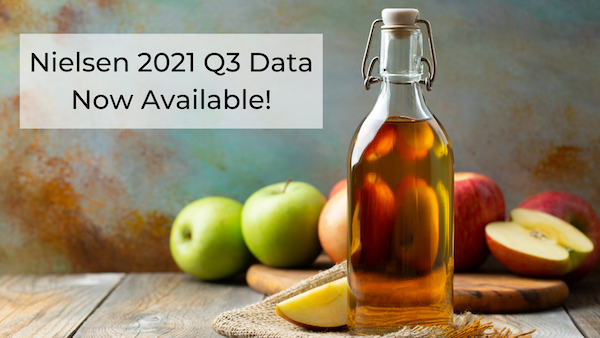
Q3 reports are available for download as part of your ACA membership benefits. Regional cider brand sales were up 11% for year over year comparisons of Nielsen-measured off-premise channels for the 52-week period ending with Q3. Total cider category sales for the 52-week period ending with Q3 were up 2% compared to 2019 and down 4% when compared to 2020 for Nielsen-measured off-premise channels. In on-premise channels, cider’s rebound for the 12-week period of Q3 compared to the same period for 2020 exceeded beer’s rebound for both draft and packaged sales. For more details on how the category is performing including regional and packaging analysis, download our members-only Nielsen reports after logging into our website.
ACA Receives Grant for “Year of the Apple” in Virginia

The American Cider Association is proud to announce a new partnership with the Virginia Department of Agriculture and Consumer Services through a USDA Specialty Crop Block Grant awarded for $70,012. Starting in early 2022, the American Cider Association (ACA) and their partners in Virginia cidermaking and agriculture will launch “The Year of The Apple,” an integrated public awareness, food industry professional outreach and market research campaign.
Virginia is the country’s 6th largest producer of apples and home to 48 independent cider makers, from the celebration-worthy bottles to adventure-ready cans. Virginia also boasts perhaps the longest and most storied history of cidermaking in North America, with apple orchards that date back to the 1600s. Yet both the restaurants and food lovers of Virginia don’t choose home-grown cider enough—Virginia has lower sales-per-capita than other cider making states.
Virginia Association of Cider Makers President Anne Shelton is excited about the opportunity the grant may bring. “Our state has a bountiful array of homegrown apple varieties, a deep history of cidermaking, and a super talented community of cidermakers crafting a wide variety of styles. We hope this grant can increase awareness around this with consumers and buyers and promote Virginia apples.”
In addition to creating awareness and understanding around Virginia cider, the grant will pay for survey research to learn more about the supply of the unique mix of apples that grow best as well as more about the state of the cider industry in Virginia.
From Shenandoah peaks to gentle ocean beaches, Virginia is home to a uniquely American diversity of landscapes, people, and ciders. “With just a little reminding, I think the drinkers of Virginia are ready to embrace the diversity and deliciousness of our uniquely Virginian ciders,” says ACA member Courtney Mailey of Blue Bee Cider in Richmond.
Letter from Board President Eleanor Leger
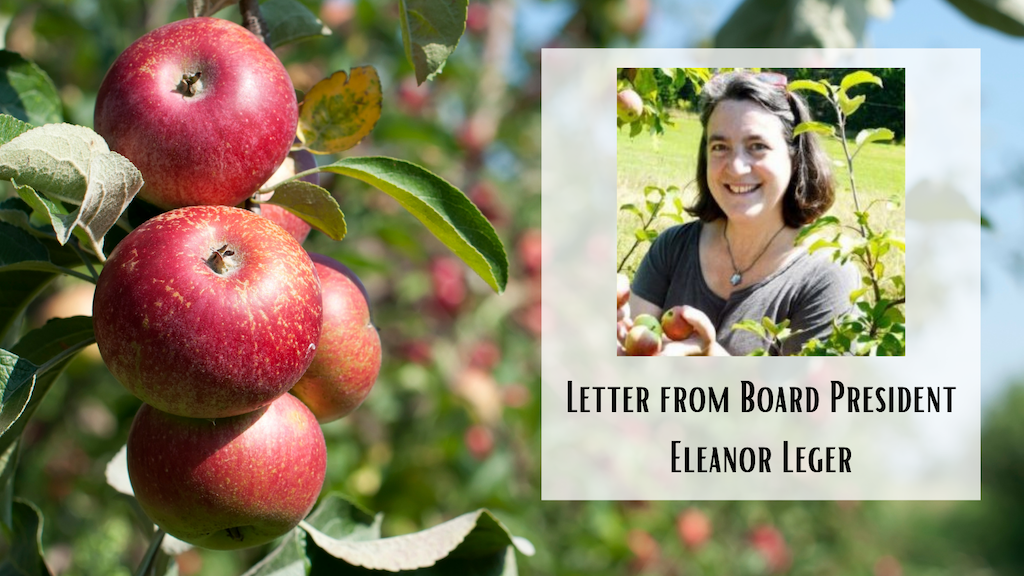
Dear Cider Friends –
As the new year begins, I am reflecting on the special challenges our incredible industry faces. 2022 will inevitably require more adaptation to supply chain issues, inflation, labor shortages, and the ongoing impact of the pandemic on sales channels and business models. These conditions are impacting all sectors of the alcoholic beverage market, but the special challenges we face in cider are a function of our small category size and the limited resources and power we have among ourselves to build awareness among consumers and achieve leverage in distribution.
I believe more than ever that cider’s future is strengthened when we draw the connection from apples to orchards to cider. Stories of growers, varieties, and the flavors that apples bring to ciders and to food pairings are what can move people to a greater appreciation of the diversity among cider offerings and a greater openness to considering cider as a choice on the shelf or at the table. These stories will benefit large and small cideries alike, across all price points and methods. Our fruit is what makes our product more expensive than grain or cane sugar based alcohols. We all must celebrate it if we are to claim the price points we need for economic sustainability across size and method. In this sense, we are truly united in our “big tent” approach. All cider is made from apples and we as a category share pride in that.
On an exciting note, we are seeing new cideries continue to open across the country. Also increasing are wineries and breweries who are adding ciders to their product line ups, including new orchard operations. These will be more voices helping to spread the word about apples and cider. Concurrently, as an association, we have invested this year in more projects to measure and report on the growth of cideries. Additionally, for the first time, we are reporting on trends in the segments of the market that are often missed by data services such as Nilsen and IRI, including cellar door and cider club sales and sales to smaller and/or regional on-premises accounts. This will allow us to create a fuller picture of the American cider market. Stay tuned for more exciting data announcements!
We are excited to include this new data perspective in our CiderCon® program in Richmond next month. The ACA team, volunteers and partners have worked hard to identify the best tracks, presenters and topics based on your feedback, from apples and orcharding to production, compliance and more. CiderCon® covers these important topics across a range of experience and business models: from enthusiast to expert, from taprooms to cider clubs, and from high volume cans to small batch natural ciders. Michelle and the Board are working to make sure we can hold CiderCon® safely in the current environment, and there will continue to be updates as the date draws nearer.
I wish all of you, your families and team members health and prosperity for 2022. In the meantime, if I can be of service, if you have questions, if you have comments or suggestions, I will always be delighted to hear from you.
